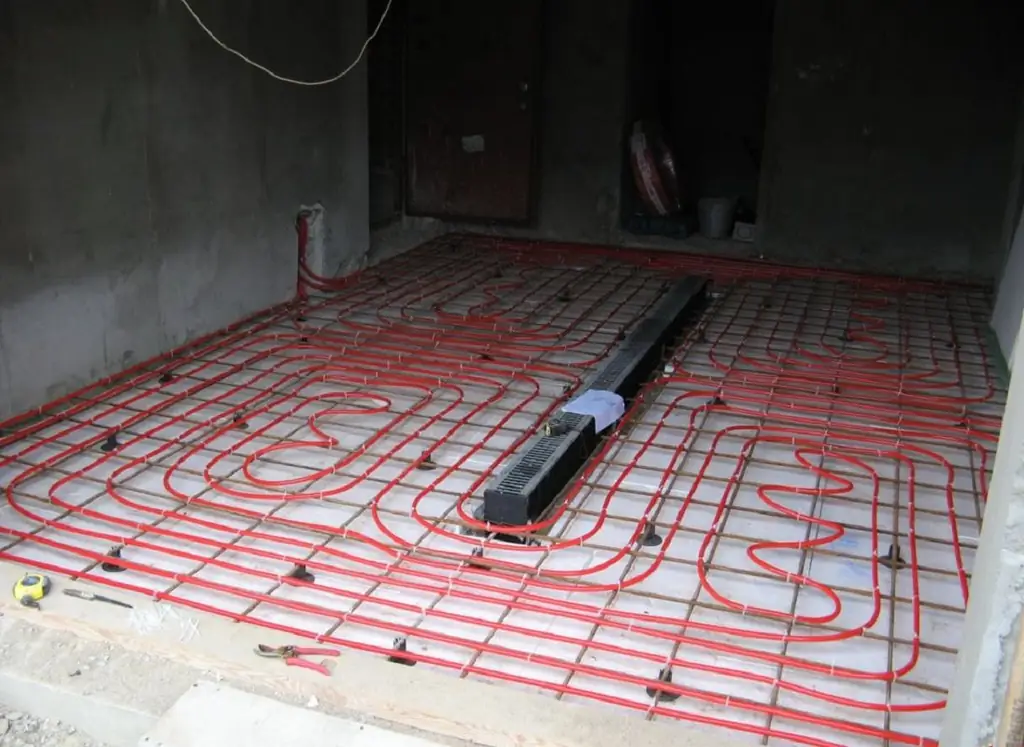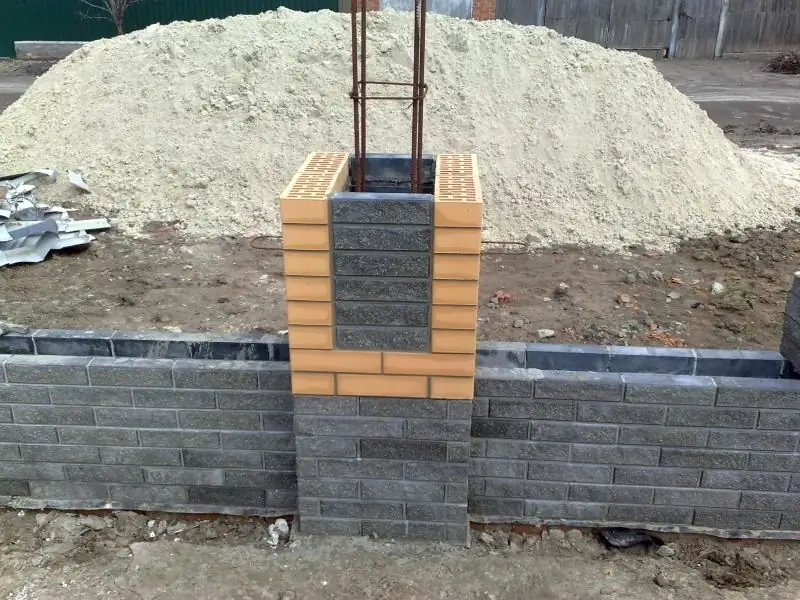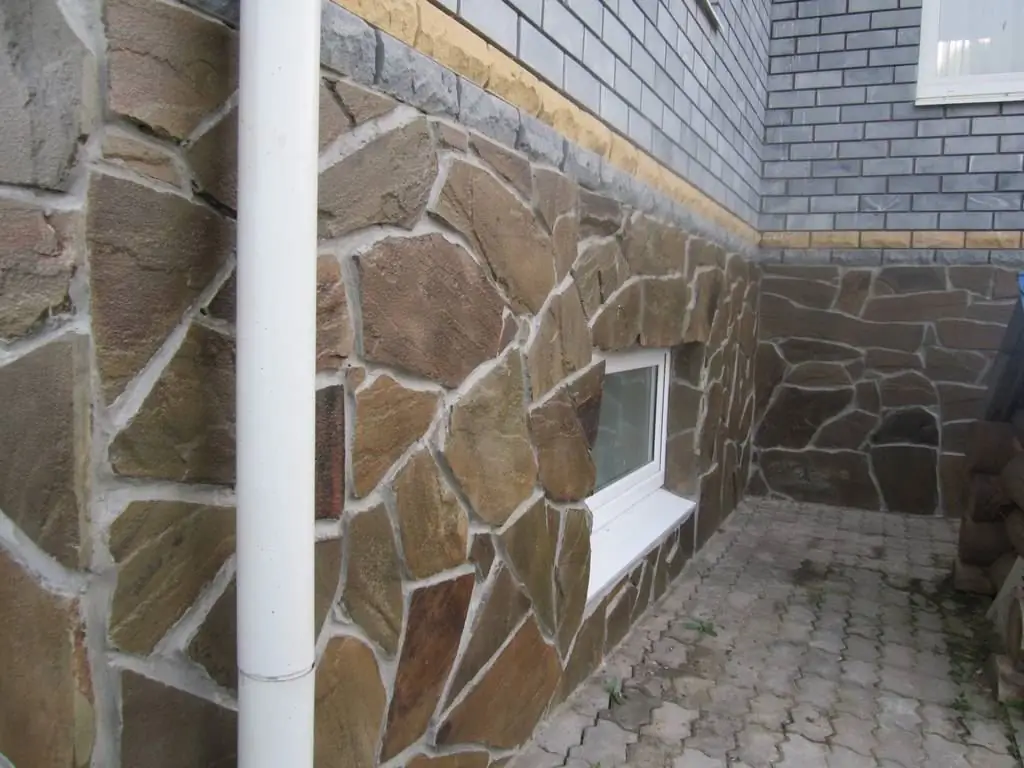
Table of contents:
- Author Bailey Albertson [email protected].
- Public 2024-01-17 22:26.
- Last modified 2025-06-01 07:32.
How to make a stone fence yourself

You bought or acquired a property. The first thing that any owner does, even before the construction of a house, is to build at least a symbolic, and more often a capital and high fence to mark the territory and hide from prying eyes. It is good if your plot or house is in a village where good-neighborly relations are still preserved. And if you have settled in a new suburban village, where no one knows anyone yet and there are a lot of work teams of unknown origin around, then a high fence is the only guarantee of your safety. But in this case, its cost can well be compared with the cost of the house itself.
There is a theory that the fence is the expression of the character of its owner. An open wattle fence is as different from a three-meter brick bastion, as a gullible extrovert is from a pragmatic unsociable.
There is a third point: the attitude to the owner that has developed over the centuries according to the height of his fence. If the fence is high and impenetrable, then either you are a good zealous owner, or you have something to hide.
The stone fence is traditional. It is better than any other fence to block the path of an intruder, beautiful and looks worthy. It's easy to make, the rules are simple. The main thing is to choose the right stone, place, height, style of the fence. If it is a stone fence that is chosen, then the decision is clear.
Content
-
1 Advantages and disadvantages of using stone for building a fence
- 1.1 Pros
- 1.2 Cons
- 2 A few simple design rules
-
3 Types and choice of stone
3.1 Photo gallery: combination of different types of stone and other materials in fences
-
4 How to make a stone fence with your own hands
-
4.1 Preparation
4.1.1 Reference consumption of materials for 1 cubic meter of stone masonry
- 4.2 Materials
- 4.3 Tools
-
4.4 Stages of construction
4.4.1 Video: how to lay a stone fence with your own hands
-
Advantages and disadvantages of using stone to build a fence
pros
This is a natural environmentally friendly material that looks expensive and beautiful. It organically fits into almost any landscape, combined with any design of the house and outbuildings. It is practically eternal and absolutely fireproof. A fence of any reasonable (and unreasonable) height can be built from stone - the foundation would be strong and sufficient thickness. The selected stone can be combined with forging, wood, or other stone.
Minuses
Such a fence is very expensive, requires the help of professionals or your solid training. Any stone fence, regardless of the type of stone chosen, requires a serious foundation. The stone may need additional processing (cutting, grinding) in place, and hydrophobization.
A few simple design rules
- A fence is part of the landscape or landscape that surrounds your home. It should be in harmony with the house, flowers, trees, garden furniture, and the design of reservoirs. If you have a design house, then the main fence and small house fences should have the same design solution.
- It is advisable to choose the type of stone that is typical for the area where your house is located. First, the logistics will be easier and cheaper. Secondly, there are probably many buildings of the same stone in the area, and your fence will look organic.
- It is believed that the color scheme of both the house and the fence should not contain more than three colors.
- Tall, opaque fences are good if the house is in a crowded place or by the road. The height should be such that only the first floor of your house is not visible.
- There should be a single style solution at the roof of your house - and at the peak of the gate and the roof (drip) of the fence.
- The wicket and gate are a very important accent in the fence. They should also fit into a single style solution of the estate.
- The greenery planted inside and outside the fence will decorate it, visually facilitate the structure. Ivy or tall plants, climbing roses or rose hips are good for a stone fence.
- Inside, along the perimeter of the site, it is good to design a walking path along the fence, planting it with flowers and bushes.
- If the site is large and the path is long, it is good to place gazebos or benches there.
Types and choice of stone
There are a lot of types of stone fences: river stone, sandstone, shell rock, granite, dolomite, and even pebbles in a wire mesh frame. There are fences, which are combinations of different options - different types of stones in one fence, stone and wood in any combination, stone with metal corrugated board, stone with forged or mesh inserts, and so on.
-
Boulders, cobblestones. Such a fence is relatively inexpensive. Large boulders and cobblestones are placed on a large amount of mortar. They are usually yellow-gray in color, rounded. Such a fence will perfectly fit into any design of the territory. On such fences, climbing plants and moss take root with pleasure, which is very beautiful. In addition, a boulder stone can be used for landscape design - to build alpine slides for flowers, pave paths for them, overlay the banks of reservoirs. And then your site will be solved in a single artistic style.

Fence River boulder fence
-
Pebbles that have a flat round or oval shape, due to their smaller size (from 1 to 15 centimeters in diameter), are more often used in gabion nets. This is a very budget option for a stone fence - but not very beautiful. If you try hard, you can put the pebbles on the mortar in the form of a fence, having previously built the formwork. Or tile a fence made of brick or other stone.

Fence Pebble fence
-
Gravel is a fine-grained rock. It is also used in gabion nets and in concrete fences. It is always part of the solution for any foundation of a stone fence, and before pouring the foundation, it is filled up and tamped into the pit.

Gravel Regular gravel
-
Marble is the most expensive material for building a fence. Therefore, you will not see a marble fence anywhere, but a marble facing of a fence built of another stone - yes. Although it is also very expensive. Smooth, therefore poorly fixed with mortar when laying.

Fence Fence lined with marble and travertine
-
Dolomite is similar to marble, but with less pronounced color and pattern. It is much cheaper, but also much more hygroscopic than marble, therefore, before laying, it requires preliminary treatment with special compounds, which is called hydrophobization. Also has a non-porous, smooth surface. Dolomite fences are very beautiful.

Dolomite Dolomite before processing
-
Granite is solidified magma. The most durable material among stones for construction, frost-resistant and heat-resistant. But it is also very expensive, therefore, like marble, it is more often used for facing a fence. It comes in black, brown, gray and dark red.

Granite Unpolished Granite Blocks for Building
-
Sandstone is also heat-resistant and durable enough. Strongly inferior in strength to marble and granite. It is easy to cut and process, therefore, as a rule, it comes on sale in the form of regular-shaped parallelepipeds. Its colors are yellow, gray-green, the color of burnt clay. Also requires hydrophobization.

Sandstone Sandstone blocks cut for construction
-
Travertine is a calcareous tuff. Very beautiful, used for building and cladding. Similar in properties and appearance to sandstone, but better in properties.

Travertine Wall cladding with travertine
-
Limestone, also known as shell rock. Formed by the remains of marine organisms, the cut shows shell imprints or the shells themselves. Cut like limestone. Poorly resistant to temperature changes and moisture, also requires hydrophobization. More often it is used not for construction, but for decoration.

Limestone Shell rock blocks
-
Rubble stone. Natural stone of volcanic origin of irregular shape, widespread and mined near Rostov. One of the most popular materials: beautiful, reliable, adheres well to any solution. The quarry is divided into three types in shape: sawn, or flagstone, a polygonal flat stone with a rough surface from 1 to 7 centimeters thick; and a torn stone is not flat, but voluminous, with a thickness of more than 7 centimeters.

Rubble stone Unsorted rubble stone
-
Fake diamond. There are several types. Porcelain stoneware is obtained by vibrational pressing of clay with the addition of paint and stone filler. Then it is fired in muffle furnaces. It can be glossy, matte, embossed and glazed, and practically does not differ in appearance from natural stone, but much cheaper.

Porcelain stoneware Wall cladding with marble effect porcelain stoneware
The agglomerate is made of polyester resin with a stone filler. Visually does not differ from natural, but much lighter and cheaper.

Agglomerate Wall cladding with agglomerate
Artificial concrete stone is made from filled concrete. The cheapest and not very high quality artificial stone.

Concrete artificial stone Facing with concrete artificial stone
-
Pergon or gabion. This French word just means "stones in a grid" - a construction of a metal mesh filled with stones. Stones can be of any type, but more often relatively small stones are used for this purpose. Pergons - ready-made boxes made of mesh with stones; the fence is simply assembled, like a constructor, using a truck crane. The gabion is mounted on site for the entire required length of the fence.

Pergons Designer pergons with stones of different colors
Photo gallery: a combination of different types of stone and other materials in fences
-

Fence - Fence made of stone with forged inserts
-

Fence - Sawn limestone fence
-

Fence - Fence made of stone with wooden boards
-

Fence - Dolomite, pebble and cobblestone fence
-

Stone fence - Buta fence with forged inserts
-

Stone fence - Buta fence with brick
-

Stone fence - Dolomite fence with plastered and painted insert
-

Stone fence - Gabion fence with empty strip planted with greenery
-

Stone fence - Rubble fence with boards
-

Stone fence - Stone fence with an insert of Italian plaster
-

Stone fence - Gabion fence with channeled mesh
-

Stone fence - Booth and dolomite
-

Stone fence - Stylization under the English fence
-

Stone fence - Cobblestone, brick, picket fence
-

Stone fence - Rubble stone with corrugated board
How to make a stone fence with your own hands
Preparation
- We determine the location of the future fence. If your site borders on a neighbor's, you will need to obtain a building permit from the neighbors.
- We determine the length, thickness and height of the future fence. The thickness can reach one meter, but more often it is about half a meter.
-
Multiplying these values, we calculate the volume of the future structure and draw a diagram.

Fence An example of a fence scheme
- When choosing a stone, think about the size. A large stone requires less installation time and less mortar. Small is more. But a large one is often so large and heavy that it will be extremely difficult to lay it on your own.
- When buying a stone, you can calculate the required amount. The manufacturer or the store always has accurate data in the table, how much of this stone will go per cubic meter of the structure's volume. Knowing the pre-calculated volume of the fence, it costs nothing to do the simplest calculations and determine how much stone will go to the fence. In the "Mason's Handbook" there is an approximate calculation of the amount of stone per cubic meter of masonry, depending on the design.
- In the same way, we calculate the required amount of concrete or other mortar. Of course, we will spend much more concrete on masonry than on brick - because of the irregular shape of the stones. In the "Handbook of the Bricklayer" such figures are given.
- But you need to understand that all these figures are purely approximate, and the final required amount of materials will depend on the skill and habits of the bricklayer and the design of the fence (how stones are placed - rarely or often, how the seams are solved, and so on). Add another 25% to the calculated amount for battle and substandard. We buy everything that we calculated.
Reference consumption of materials for 1 cubic meter of stone masonry
Approximate consumption of stone per cubic meter of fence, depending on the type of masonry
| The usual way of laying | Laying in rows |
| 0.9 m 3 | 0.98 m 3 |
The approximate ratio of the amount of stone and mortar, depending on the density of laying when laying without gravel backfill.
| Natural stones (or artificial with voids inside) | 0.95 m 3 | 0.9 m 3 | 0.96 m 3 | 0.93 m 3 |
| Concrete or mortar | 0.095 m 3 | 0.110 m 3 | 0.092 m 3 | 0.111 m 3 |
The approximate ratio of the amount of stone, gravel (or fuel slag for backfill) and mortar, depending on the density of laying when laying with gravel backfill.
| Natural stones (or artificial with voids inside) | 0.95 m 3 | 0.9 m 3 | 0.96 m 3 | 0.93 m 3 |
| Concrete or mortar | 0.095 m 3 | 0.110 m 3 | 0.092 m 3 | 0.111 m 3 |
| Gravel or slag | 0.27 m 3 | 0.26 m 3 | 0.27 m 3 | 0.26 m 3 |
Materials
| Cement | brand not lower than М400 | According to the calculation |
| Sand | homogeneous small | According to the calculation |
| Gravel | for the foundation | According to the calculation |
| Stone for building | According to the calculation | |
| Channel for supports | channel 60x60 mm | According to the calculation |
| Armature | 8-15 mm | According to the calculation |
| Formwork boards | According to the calculation | |
| Beam for formwork | section 20x40 mm | According to the calculation |
| Waterproofing | roofing felt | According to the calculation |
Tools
| Digging shovels | 1-2 pieces |
| A machine for mixing concrete (or a shovel and a container for mixing concrete) | 1 piece |
| Chopper (or grinder with special attachments for splitting or cutting stone) | 1 piece |
| A hammer | 1 piece |
| Nails | According to the calculation |
| Clipper | 1 piece |
| Plumb line (level) | 1 piece |
Construction stages
-
We mark the territory with twine and pegs.

Fence marking We mark the future fence on the territory
-
Digging a trench under the strip foundation. There is a rule: the width of the pit is 15 centimeters larger than the thickness of the future fence; its depth is 70-80 centimeters for a fence up to two meters high. If the fence is higher, then the trench is made deeper: 10 centimeters for each extra meter of height.

Fence 3D foundation modeling
-
Determine the location of the support pillars, they should stand every 2.5-3 meters. Without such pillars, the structure will be much less durable. Concrete pillars are poured on their own.

Fence An example of a foundation and supports diagram
But there is an alternative - ready-made concrete block supports. These hollow posts can hold electrical wires to illuminate the fence.

Block Hollow block for support post
- At the bottom of the trench we tamp crushed stone or gravel 3-5 centimeters thick.
- We put reinforcement there (with a section of 8 to 14 millimeters).
-
We assemble the formwork from the boards so that the foundation after pouring is 10 centimeters above the ground.

Formwork Formwork assembled in a trench
-
We mix the concrete, if possible, for the entire trench at once.

Concrete Mixing concrete with a special "mixer"
- We fill the trench with concrete.
- We lay waterproofing (roofing material) over the concrete.
- In the places designated for the supports, we fasten the reinforcement structures for the supports in concrete.
- We put concrete support blocks on the reinforcement.
- Fill the holes in the concrete blocks with concrete. The supports become monolithic.
-
You don't have to use ready-made blocks. In this case, a square sliding formwork is mounted in the shape of the posts. Reinforcement is placed inside and cobblestones are successively placed.

Casting support Pouring the support into the formwork
-
Concrete is poured into the formwork, it moves, the process repeats.

Support Sliding formwork is a great thing
- The post will be a single structure with a strip foundation.
-
Several anchors - pins for better contact and adhesion to the span - are laid in the support posts.

Foundation A diagram of the foundation and supports, anchors are visible, instead of a film, a drip is drawn
- The support should rise 20-25 centimeters above the future fence.
- We cover the foundation from above with a film that protects against cracking and rain.
- We forget about the foundation for 2 weeks.
- We disassemble the formwork.
-
You can start laying the spans. If our stones are small, then we will have to build a new formwork for each span. If it is large, just pull the bounding strings.

Fence Finished foundations and supports
-
A thick layer of mortar is placed on the waterproofing along the entire length of the span. The stones are sequentially laid along the edges of the foundation, a solution is laid between them. Allow the mortar to harden as each row of stones is laid. Therefore, the spans are in operation sequentially.

Fence Span construction
-
The next row of stones should overlap, or, as the builders say when laying bricks, “with bandaging”. Each upper stone should rest on 2-3 lower ones. Only in this way will the fence come out strong and monolithic.

Fence Laying with bandaging
- For the top row, approximately the same stones are selected.
- After laying and drying the top row, a screed is made on it with a solution.
-
Cement joints can be filled in and laid out, which will give the fence a finished look and keep it from nests of small insects.

Fence Example of jointing
- When everything is completely dry, you can start installing the roof (dropper). But you can do without it by making a "ridge" of cement mortar 1: 1 along the top of the fence (one part of cement for one part of sand).
-
The fence is ready.

Fence Finished fence
Video: how to lay a stone fence with your own hands
A beautiful stone fence is a marker of prosperity and well-being. And if it is made by hand, then pride for these hands.
Recommended:
How To Make A Veranda With Your Own Hands To The House - Instructions, Projects, Drawings, Photos And Videos

The article describes how to build a veranda close to the house with your own hands
How To Make Heating For A Garage With Your Own Hands - Instructions With Photos And Videos

Various methods of heating the garage, their efficiency and cost, as well as detailed instructions that will allow you to do all the work yourself
How To Install Fence Posts With Your Own Hands, Including Without Concreting, At The Correct Distance And Depth - Instructions With Photos And Videos

How to install fence posts: installation methods, use of suitable materials
How To Make A Slime At Home With Your Own Hands - Without Sodium Tetraborate And Glue, From Hand Cream, Shaving Foam And Other Ingredients, Recipes With Photos And Videos

Is it possible to make a slime at home. Types of slimes and recipes for their manufacture, depending on the desired properties. Toy care features
Facing The Basement With A Stone Or Finishing The Basement With A Stone With Your Own Hands

Facing the basement with a stone with your own hands - step-by-step instructions for carrying out the work. How to finish the basement with sandstone stone without the involvement of specialists
